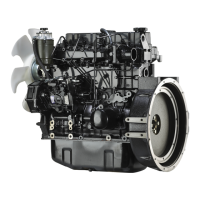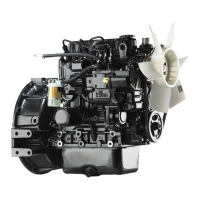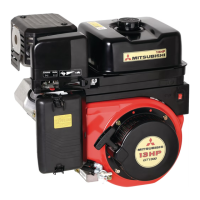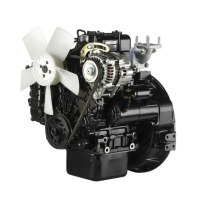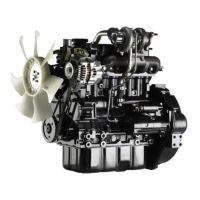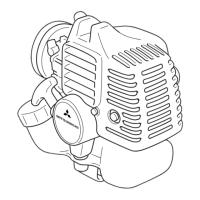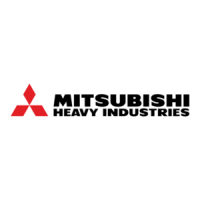
Do you have a question about the Mitsubishi Heavy Industries BD2G and is the answer not in the manual?
| Brand | Mitsubishi Heavy Industries |
|---|---|
| Model | BD2G |
| Category | Engine |
| Language | English |
Details on where to find chassis and engine serial numbers for the BD2G model.
Details on where to find chassis and engine serial numbers for the BS3G model.
Explains the function and operation of steering, transmission, and brake controls.
Details the operation of the accelerator and clutch pedals.
Describes the power angling/tilt and power tilt control levers.
Explains OK monitor, test switch, and warning lamps functions.
Covers water temperature, service meter, fuel gauges, and various switches.
Details the fuse box layout and the function of each fuse.
Explains the meaning and action for indicator lamps like alternator and oil pressure.
Describes the horn switch and operator seat adjustments.
Explains the function and operation of steering, transmission, and brake controls.
Details the operation of the accelerator and clutch pedals.
Describes the operation of the bucket control lever and safety lock.
Explains OK monitor, test switch, and warning lamps functions.
Covers water temperature, service meter, fuel gauges, and various switches.
Details the fuse box layout and the function of each fuse.
Explains the meaning and action for indicator lamps like alternator and oil pressure.
Describes the horn switch and operator seat adjustments.
Provides general advice for special servicing and measurement intervals.
Details safety measures to avoid accidents during maintenance tasks.
Covers safety tags, keeping personnel clear, ventilation, and hot parts.
Advises on handling battery electrolyte, fuel, and hot exhaust pipes safely.
Lists essential checks for bolts, fluids, electrical systems before operation.
Advises on break-in period, warming up, and engine revving.
Details the steps for starting the engine, including pre-start checks and warnings.
Outlines the procedure for safely stopping the engine with cautions.
Explains how to move the machine using DD and DPS control systems.
Describes how to perform turns and handle steering clutches.
Provides cautions regarding sharp turns and foot placement on pedals.
Details how to change speed or direction using DD and DPS controls.
Explains how to stop the machine using DD and DPS systems.
Covers safe practices when leaving the machine or parking on slopes.
Guides on operating uphill, downhill, over obstacles, and shifting on slopes.
Warns against exceeding stability limits and free-wheeling downhill.
Advises on operating in mud, water, rocky terrain, and snow.
Provides specific advice for swamp and ultra swamp model operation.
Details cautions for stripping/leveling and securing the bucket.
Covers regulations, platform/ramp use, and securement during transport.
Advises on lubricants, fuels, coolant, and battery maintenance in cold weather.
Details engine starting procedures and post-operation care in cold.
Covers operation, lubrication, battery, coolant, and post-operation in hot weather.
Advises on cleaning air cleaners, breathers, and radiator in dusty conditions.
Covers battery inspection, charging, and safe removal/installation.
Details the correct procedure for jump-starting a vehicle.
Provides instructions for storing the machine short-term and long-term.
Details care during storage and steps for releasing the machine from storage.
Diagnoses causes and solutions for starter not cranking or cranking slowly.
Provides troubleshooting steps for when the engine cranks but does not start.
Identifies causes for reduced engine power, such as oil grade or fuel issues.
Explains the meaning of white or blue exhaust smoke.
Lists reasons for black or gray exhaust smoke and their solutions.
Addresses causes for excessive fuel or oil consumption.
Details reasons why the engine oil pressure warning lamp glows and corrective actions.
Diagnoses issues like clutch slips, drags, and abnormal oil temperature.
Addresses problems like chattering, hard shifting, and clutch drags.
Diagnoses causes for gears slipping or noisy transmission operation.
Covers overheating, no power, and noisy operation in the DPS transmission.
Diagnoses problems related to steering clutch slips, drags, and brake engagement.
Addresses problems with sprocket wear, track looseness, and implement operation.
Lists safety-critical parts like hoses that require periodic replacement.
Details daily pre-operation checks and 250-hour or monthly maintenance items.
Lists maintenance tasks for 500, 1000, and 2000-hour intervals.
Outlines the maintenance required after the first 100 service hours.
Lists components to inspect before operating the machine and explains symbols.
Details checks for oil and coolant levels in various systems.
Covers checks for brake, inching, clutch pedals, and transmission control levers.
Details track adjustment and implement wear/damage inspection.
Instructions for checking fan belt tension and battery electrolyte level.
Identifies fittings for lubricating implement parts on BS3G and straight blade.
Details tasks for 500-hour service including strainer wash, filter wash, oil checks.
Covers changing engine oil filter, fuel filter, and lubricating the universal joint.
Details oil change procedures for various drive train components.
Covers transmission filter, hydraulic fluid, coolant, and air cleaner maintenance.
Provides instructions for cleaning and inspecting the air cleaner element.
Details the steps for priming the fuel system after filter changes or fuel depletion.
Explains how to loosen and adjust track sag and tension.
Details adjustments for steering clutch lever position and clearance.
Covers adjusting the free play and stroke of brake and inching pedals.
Details adjustments for clutch pedal, clutch brake, and transmission control lever.
Explains how to adjust the blade tip angle for different digging actions.



